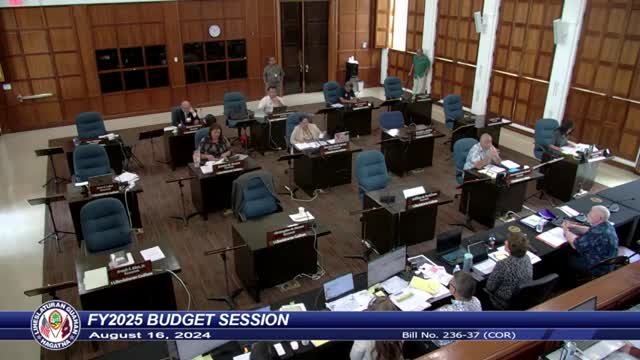Lawmakers question sustainability of skyrocketing budget increases
August 16, 2024 | General Government Operations and Appropriations , Legislative, Guam

This article was created by AI summarizing key points discussed. AI makes mistakes, so for full details and context, please refer to the video of the full meeting. Please report any errors so we can fix them. Report an error »

In a recent government meeting, officials discussed the significant increases in operational costs and budget allocations over the past few years, raising concerns about the sustainability of such growth. The proposed budget for fiscal year 2025 includes an increase of approximately $352 million in operational costs, with overall appropriations reaching about $1.3 billion over the last three years. This marks an 8% increase for 2023, a 12% increase for 2024, and a projected 10% increase for the upcoming fiscal year.
Senator Blase highlighted the unprecedented nature of these growth rates and questioned whether the government could sustain such increases in the long term. He sought insights from Mister Burns, a representative of the administration, regarding the anticipated revenues and their ability to meet the rising costs associated with payroll, insurance, and other recurring expenses. Burns acknowledged the challenges but expressed confidence that revenues would be sufficient to cover expected costs for fiscal 2025.
Concerns were also raised about the long-term implications of these budgetary decisions, particularly regarding the absorption of costs previously covered by federal funds. Senators questioned the lack of clarity on who made decisions about incorporating these costs into the general fund and whether there were plans for cost-cutting measures to offset the growing budget.
Burns emphasized that a significant portion of the increased government spending is directed back into the community, particularly in public health and education. However, some senators expressed skepticism about the effectiveness of these expenditures, citing issues such as reduced outreach by public health services and the ongoing financial challenges faced by local hospitals.
As the government navigates these fiscal challenges, the discussions underscore the need for careful consideration of budgetary sustainability and the impact of rising costs on both the administration and the community it serves.
Senator Blase highlighted the unprecedented nature of these growth rates and questioned whether the government could sustain such increases in the long term. He sought insights from Mister Burns, a representative of the administration, regarding the anticipated revenues and their ability to meet the rising costs associated with payroll, insurance, and other recurring expenses. Burns acknowledged the challenges but expressed confidence that revenues would be sufficient to cover expected costs for fiscal 2025.
Concerns were also raised about the long-term implications of these budgetary decisions, particularly regarding the absorption of costs previously covered by federal funds. Senators questioned the lack of clarity on who made decisions about incorporating these costs into the general fund and whether there were plans for cost-cutting measures to offset the growing budget.
Burns emphasized that a significant portion of the increased government spending is directed back into the community, particularly in public health and education. However, some senators expressed skepticism about the effectiveness of these expenditures, citing issues such as reduced outreach by public health services and the ongoing financial challenges faced by local hospitals.
As the government navigates these fiscal challenges, the discussions underscore the need for careful consideration of budgetary sustainability and the impact of rising costs on both the administration and the community it serves.
View full meeting
This article is based on a recent meeting—watch the full video and explore the complete transcript for deeper insights into the discussion.
View full meeting